A Walk Through History
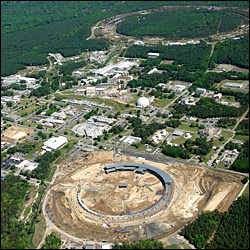
An aerial view of Brookhaven National Laboratory
Since its inception in 1947, Brookhaven National Laboratory (BNL) has been a leader in particle and nuclear physics experiments on site and around the globe. Those nearly 65 years of advances and breakthroughs have resulted in seven Nobel Prizes and insights into some of the most puzzling questions about matter and the universe, as well as discoveries in other scientific fields. In recognition of this work, the American Physical Society (APS) has named Brookhaven a historic site, a designation given to about 20 honorees since 2004. This is the first time an entire national laboratory has received the prestigious recognition. In the following timeline, take a walk through some of the Lab's greatest physics accomplishments.
BNL and APS: Connected by Science
In 1951, the APS appointed Brookhaven's Physics Department Chair Sam Goudsmit as managing editor of Physical Review, and BNL physicist Simon Pasternack as assistant editor. The journal's offices moved from Minnesota to Brookhaven, signaling the start of a deep connection between the Lab and APS that continues to this day.
In 1958, Goudsmit founded Physical Review Letters (PRL) as a separate "rapid publication" journal, which has since become one of the most prestigious journals in the physics field. The offices of both journals remained at Brookhaven until the need for space — both on the part of the journals and of the Lab — became too pressing. At that time, a new APS building was constructed across the street north on William Floyd Parkway.
1947-1957
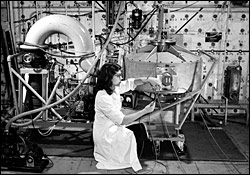
Working inside the Brookhaven Graphite Research Reactor, the first peacetime reactor constructed in the United States
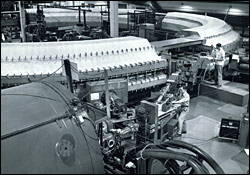
The Cosmotron, which sent protons to previously unheard-of energies
The first decade of Brookhaven's history saw the opening of two unique facilities for physics research: the Brookhaven Graphite Research Reactor (BGRR) — the first peacetime reactor constructed in the United States, where researchers developed the most widely used radioisotope for diagnosing diseased organs (technetium-99m) — and the Cosmotron, the highest-energy accelerator of the time.
The Cosmotron sent protons to previously unheard of energies (the billion-electron-volts, or GeV, region) and led to a number of immediate findings, including the discovery of the long-lived neutral kaon, and evidence that the fundamental and supposedly absolute law of parity conservation had been violated (research that led to the 1957 Nobel Prize in Physics). But as the record-breaking machine started up, Brookhaven physicists were already figuring out how to push the energy frontier even higher.
In order to produce a cost-effective accelerator with 10 times more power, Brookhaven physicists calculated that reversing the direction of the Cosmotron's "C"-shaped magnets resulted in a much more tightly focused proton beam. The strong-focusing principle was born. The discovery meant that more powerful machines could be built with smaller magnets and less cash. It now serves as the basis for most of the world's accelerators.
1958-1968
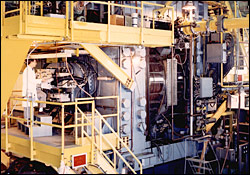
The 80-inch bubble chamber at the Alternating Gradient Synchrotron was once the largest particle detector of its type in the world
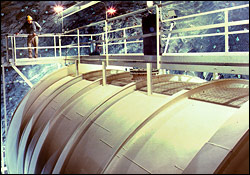
About a mile under solid rock in South Dakota's Homestake Gold Mine, BNL researchers set up a chlorine-filled detector to measure neutrinos from the sun.
Brookhaven scientists saw the advantages of strong focusing with the startup of the Alternating Gradient Synchrotron (AGS), which set records by accelerating protons to 33-billion electron volts. In its first years of operation, the AGS led to the discovery of the muon neutrino, securing the 1988 Nobel Prize in Physics; the omega-minus particle, found through tracks in the 80-inch bubble chamber at AGS; and charge parity (CP) violation, key to understanding why our universe is almost completely made up of matter and not equal amounts of matter and antimatter — a discovery that led to the 1980 Nobel Prize in Physics.
Two more reactors joined the Brookhaven Graphite Research Reactor: the Brookhaven Medical Research Reactor and the High Flux Beam Reactor, which produced neutrons for studies in medicine, condensed matter physics, nuclear physics, and chemistry studies. The suite of reactors (dismantled in 1968, 2000, and 1999, respectively) also allowed the first application of neutron activation autoradiography, used to analyze oil paintings, sculptures, and archaeological artifacts.
BNL scientists determined that a ghostly type of particle called a neutrino has a spin that's opposite to its momentum, giving it "negative helicity." In a mine in South Dakota, BNL scientists were the first to confirm that the sun produces neutrinos, but only about one third of the number predicted by theory. The discovery of this "solar neutrino deficit" led to the 2002 Nobel Prize in Physics.
Brookhaven scientists also built a circular detector for early brain-imaging studies, a precursor to today's positron emission tomography machines; developed L-dopa as a treatment for Parkinson's disease; and patented Maglev, the principle of superfast magnetically levitated transportation.
1969-1979
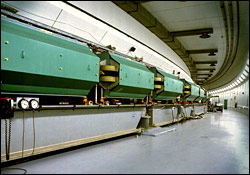
The Alternating Gradient Synchrotron set records by accelerating protons to 33-billion electron volts and led to numerous discoveries.
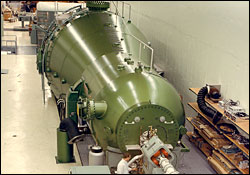
The Tandem Van de Graaff facility was for many years one of the world's largest electrostatic accelerator facilities.
The Alternating Gradient Synchrotron (AGS) continued to yield scientific advances, including the discovery of the J/psi particle, which led to the 1976 Nobel Prize in Physics, and the discovery of the charmed baryon, a three-quark particle revealed through the seven-foot bubble chamber at AGS.
The same was true at the High Flux Beam Reactor, where scientists proposed spin and charge separation in one-dimensional conductors, made a direct measurement of electron-phonon coupling in superconductors, and studied critical phenomena in magnetic and structural phase transitions.
Brookhaven researchers were the first to use computing and moving pictures to study the system of spins in a model magnet. Also using large computers, BNL scientists applied the Monte Carlo method (statistical sampling strung over a three-dimensional lattice) to relativistic quantum theory, the primary tool of elementary particle physics.
Three new facilities came online: the Tandem Van de Graaff, one of the world's largest electrostatic accelerator facilities; the Brookhaven Linac Isotope Producer, which still generates radioisotopes for biomedical and industrial applications; and the Scanning Transmission Electron microscope, one of only three high-resolution microscopes in the world that could easily image single heavy atoms.
Brookhaven researchers also investigated light-induced electron transfer reactions — useful for complex chemical reactions like photosynthesis and corrosion — and developed a new particle detection method, liquid argon calorimetry.
Meanwhile, BNL scientists were hard at work on a novel design for the magnet configuration of storage rings dedicated to synchrotron radiation research. This design, called the "Chasman-Green lattice," was the basis for the National Synchrotron Light Source and many other light sources around the world.
1980-1990
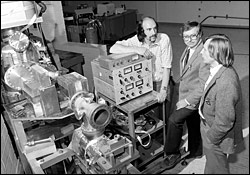
NSLS scientists discuss the first beamline on the Vacuum Ultraviolet Ring, one of two synchrotron rings at NSLS.
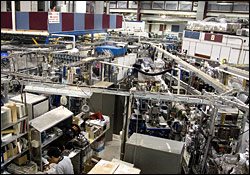
The NSLS experimental floor
The National Synchrotron Light Source (NSLS) opened its doors, starting the Lab's longtime commitment to photon science research. As the first facility dedicated to producing synchrotron radiation (particle physicists previously viewed synchrotron radiation as a nuisance because it sapped the energy from their machines), NSLS became a valuable tool for research in fields ranging from biology and chemistry to condensed matter physics and materials science.
For more than half a century, neutrons were the only experimental tools used to study magnetic structures and phase transitions. But at NSLS, a new technique — resonant magnetic x-ray scattering — was developed and used to explore a wide range of fundamental problems in magnetism.
At the High Flux Beam Reactor, scientists discovered antiferromagnetism (a condition in which adjacent magnetic atoms have their north poles pointing in opposite directions) in parent compounds of high-temperature superconductors — materials that conduct electricity without resistance.
Scientists at Brookhaven and the Polytechnic Institute of Milan invented the silicon drift chamber, a detector used in experiments around the world.
BNL researchers proposed the theory of self-organized criticality, a theory that links the behavior of complex natural phenomena to physics laws. And physicists at the Alternating Gradient Synchrotron began producing polarized protons, protons whose spins have been aligned in the same direction, at the highest energy ever — 16.5 GeV.
1991-2001
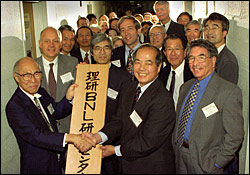
Scientists from RIKEN in Japan and Brookhaven Lab celebrate the opening of a joint research center.
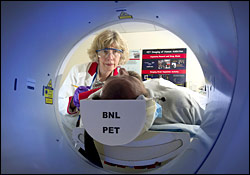
Using positron emission tomography, Brookhaven researchers unlock the mysteries of addiction and other pathologies.
The Accelerator Test Facility started providing experimenters with equipment to advance accelerator technology that's small and more cost-effective. Operations also started at the Laser-Electron Accelerator Facility, a picosecond laser-electron accelerator facility at Brookhaven's Center for Radiation Chemistry Research.
The Alternating Gradient Synchrotron (AGS) began accelerating gold nuclei to study high-density matter, which, along with the already existing proton program, paved the way for studies at the Relativistic Heavy Ion Collider (RHIC). A few years later, the AGS achieved the highest baryon (protons, neutrons, and other particles made up of quarks) density in gold-gold collisions. Scientists at the AGS also spotted (for a second time) one of the rarest occurrences in the subatomic world: the decay of a kaon into a positively charged pion, a neutrino, and an antineutrino.
As part of the lead-up to RHIC, the RIKEN-BNL Research Center was established and dedicated to the study of spin physics and quantum chromodynamics (QCD) the model of matter based on the "strong force" that binds quarks and gluons in the particles that make up the center of every atom in the universe.
At the National Synchrotron Light Source, researchers discovered that a fundamental type of energy state known as a "quantum well" could be spin-polarized. Other condensed matter physicists found evidence that the electronic structure of high-temperature superconductors consists of fluctuating strings of charge, known as stripes.
With positron emission tomography, the development of which was pioneered at BNL, Brookhaven scientists were the first to report that people addicted to cocaine, alcohol, and heroin show reduced activity in their brain's dopamine system.
2002-now
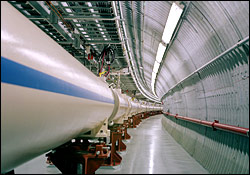
The Relativistic Heavy Ion Collider is really two accelerators in one — made of crisscrossing rings of superconducting magnets, enclosed in a tunnel 2.4 miles in circumference. In the two rings, beams of heavy ions are accelerated to nearly the speed of light in opposite directions, held in their orbits by powerful magnetic fields before they collide.
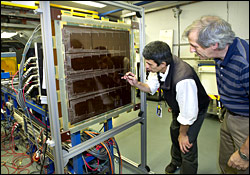
The NASA Space Radiation Laboratory, where scientists study the possible biological risks to human beings exposed to space radiation
The Relativistic Heavy Ion Collider (RHIC) started running in 2000 and after years of data analysis, a new state of matter called quark-gluon plasma was revealed. Surprisingly, instead of behaving like a gas, as scientists had predicted, this matter appears to be more like a liquid, a "perfect" liquid with virtually no viscosity. Powered by the same initial particle injection line that feeds RHIC, the NASA Space Radiation Laboratory startup gives a boost to scientists studying the effects of simulated space radiation on biological and physical systems.
After collecting data from more than one billion decay events in Brookhaven's muon g-2 experiment, physicists announce a possible violation of the Standard Model.
Across the ocean, Brookhaven physicists and engineers began playing a major role in the startup of the world's most powerful particle smasher, the Large Hadron Collider at CERN. In Canada, Brookhaven scientists took part in the Sudbury Neutrino Observatory experiment, which showed that electron neutrinos change type.
Visiting scientists took home two Nobel Prizes in Chemistry for work conducted, in part, at the National Synchrotron Light Source. The 2003 prize was given for work that explained how a class of proteins called ion channels help generate nerve impulses, and the 2009 prize recognized research that illuminated the structure and function of the ribosome, a cellular complex responsible for producing the thousands of proteins that are required for living cells.
Now under construction at Brookhaven, the National Synchrotron Light Source II will produce x-rays 10,000 times brighter than NSLS, enabling researchers to tackle some of the nation's most important scientific challenges.


